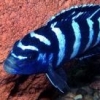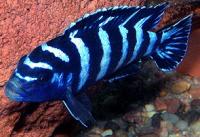They can survive, i got around 15 youngsters from my Trewavasae in my tank, and they are now ignored by the other fish (3-4cm) and can swim freely.
Not sure how big yours are, at least a few can survive.
- scottvh likes this
PCS & Stuart M. Grant - Cichlid Preservation Fund - Details here
My name is Joshua Grigoleit
I've been keeping fish since i was 8 years old, and i went over to Malawi Cichlids when i was 13 years old.
Now i'm seeking some help on this site, and i will try to help others aswell!,
 Posted by Malawi Freak
on 20 July 2013 - 10:54 PM
Posted by Malawi Freak
on 20 July 2013 - 10:54 PM
They can survive, i got around 15 youngsters from my Trewavasae in my tank, and they are now ignored by the other fish (3-4cm) and can swim freely.
Not sure how big yours are, at least a few can survive.
 Posted by Malawi Freak
on 02 July 2013 - 01:59 AM
Posted by Malawi Freak
on 02 July 2013 - 01:59 AM
She will not eat the fry if she gets something to eat from you.
Or well she will if you keep her alone together with the fry too long after she did the final release.
But just as soon you see she doesn't pick them up anymore you can just take her into the tank with the other fish again.
 Posted by Malawi Freak
on 25 June 2013 - 11:36 PM
Posted by Malawi Freak
on 25 June 2013 - 11:36 PM
 Posted by Malawi Freak
on 17 June 2013 - 09:04 PM
Posted by Malawi Freak
on 17 June 2013 - 09:04 PM
Eretmodus cyanostictus
Pictures
Eretmodus Cyanostictus

Eretmodus cyanostictus mbilibili

Bulu Point
Eretmodus sp. cyanostictus Orange Fullbar "Kigoma"

Eretmodus cyanostictus sp. north Burundi
Description
A little history:
Breeding Behaviour:
Number of offspring
10-16
Horse Nose Cichlid
Size Male
9 cm
(North) 8 cm
Size Female
7
(North) 6 cm
Best Conditions
 Posted by Malawi Freak
on 13 June 2013 - 05:44 PM
Posted by Malawi Freak
on 13 June 2013 - 05:44 PM
Petrochromis sp. "Moshi Yellow"
Pictures

Male

Pair

Offspring
Description
A little history:
Breeding Behaviour:
Petrochromis P. sp. "moshi yellow" is a mouthbrooder, where the female alone is responsible for mouthbrooding, which normally lasts about 4 weeks.
Number of offspring
10-25
sp. "Moshi Yellow"
 Posted by Malawi Freak
on 10 June 2013 - 07:43 PM
Posted by Malawi Freak
on 10 June 2013 - 07:43 PM
 Posted by Malawi Freak
on 08 June 2013 - 11:46 PM
Posted by Malawi Freak
on 08 June 2013 - 11:46 PM
i know that, it's quite easy to see you were making a joke.
You almost got me though, was wondering if there was a fish i haven't heard about... ![]()
 Posted by Malawi Freak
on 07 June 2013 - 10:44 PM
Posted by Malawi Freak
on 07 June 2013 - 10:44 PM
Pseudotropheus Williamsi
Pictures

Male
Pseudotropheus Williamsi North Makonde

Female
Pseudotropheus Williamsi North Makonde
Description
In the aquarium they need a good stone setting with lots of caves. If you want to imitate nature a little, they should have a strong circulation, but this is not a necessity. The males are very territorial towards males of the same species, but other species it leaves alone. You should have 2-3 females to every male. If you have more than one male, one must be sure to have many caves. They have a reputation for being very bold, and they are hiding often.
Williamsi North Orange become more aggressive with age and should not be housed with calmer tank mates.
A little history:
Pseudotropheus williamsi found at Likoma Island, Mbenji Island, Painting Iceland and Chizumulu Island. Here it finds its food on open water. It consists to a large extent on plankton, but also invertebrates and insects that come floating through the water. It has been seen a few times eating of the sediment on the rocks. It lives in shallow water inside the rocky coasts.
It is one of the largest Pseudotropheus types. Males can reach up to 17 cm. Many call them Blue Lips as both males and females have blue lips.
Males have a very large territory, but it is only males of the same species which are being chased away. They do not eat much when they are in play mood because they're so busy taking care of their large territory. The male entices as soon as there is a female around it. The female carries the offspring around 3 weeks.
Their territory will only be defended against males of the same species, other cichlids are mostly allowed to be in the territory. They are not particularly difficult to get to breed in aquarium conditions. After 20-24 days the female releases her brood who loves shrimp.
Number of offspring
40-50
Colours: Pseudotropheus Williamsi North Makonde
The male is light blue on the body that fade into a yellowish color towards the head. The female is yellow with black spots and blue lips and fins.
Colours: General
Males vary in color depending on which locality they come from. We know them mainly as dark, but with a nice blue or yellow color that covers most of the body, and with reddish fins. They all have yellow eggspots. All variants have blue lips. But as I said males variate with their looks depending on their locality. Example males from Chizumulu is very similar to Pseudotropheus socolodi with the same blue base color and black colors on the edge of the fins.
Females are actually pretty good looking also. They have a light ground color, but with a portion of the yellow contrasts. In addition, the black dots along the body and blue lips. Overall, P. williamsi unfortunately a reputation for very easy to throwing it's beautiful colors, as it is quite demanding to not be afraid in the aquarium.
Algies
Cichlidsticks
Crisp
Flakes
 Posted by Malawi Freak
on 05 June 2013 - 08:38 PM
Posted by Malawi Freak
on 05 June 2013 - 08:38 PM
pseudotropheus acei 'Ngara'
If you want to. Your doing a great job
Go and check it out now, made one for Acei, Acei Ngara and Gephyrochromis Moorii (Which is related to Acei)
 Posted by Malawi Freak
on 03 June 2013 - 10:40 PM
Posted by Malawi Freak
on 03 June 2013 - 10:40 PM
Hello people, i want to show off my aquarium!; Tell me what you think!:
Here's a video!;
The video is a bit old, i'm currently working on a new one!;
And here's a few pictures!;






 Find content
Find content